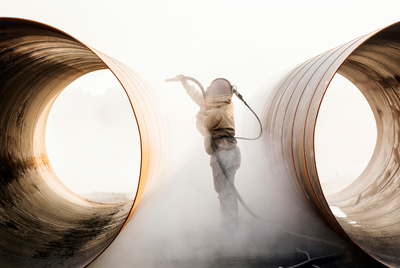11th Apr 2024
Choosing sandblasting equipment (sandblasting is outdated terminology; this process is now known as abrasive blasting, but for the sake of the article we will use the previous term) depends on several factors, such as the type of surface you'll be blasting, the size of the project, your budget, and your specific needs. Here's a step-by-step guide to help you select the right sandblasting equipment:
1. Determine the Application: Understand what you'll be using the sandblasting equipment for. Are you removing rust, paint, or corrosion from metal surfaces? Are you etching designs on glass or stone? Different applications may require different types of sandblasting equipment, abrasives, and blast pressures.
2. Consider the Surface: The material and surface condition you'll be working on are critical. Some surfaces are more delicate and require a gentler approach, while others can handle more aggressive sandblasting. For example, blasting wood requires different equipment compared to blasting concrete or heavy corrosion on steel.
3. Choose the Right Abrasive: The type of abrasive material you use is crucial. Common abrasives include glassia, garnet, aluminium oxide, and glass beads, among others. Each abrasive has its characteristics in terms of hardness, shape, and size, affecting the blasting process, its cleaning action, and the surface finish.
4. Select the Type of Sandblaster: Portable sandblast machines are suitable for most outdoor projects or to be used inside a blast room. They use a pressurised system to propel abrasive material. For smaller components, a blast cabinet would be more suitable.
5. Consider the Size of the Project: The size of the area you'll be blasting and the volume of work you need to complete will influence the size and capacity of the equipment you choose. For large-scale projects, you'll need a more powerful and efficient sandblaster, typically units larger than 50ltrs.
6. Evaluate Portability and Mobility: Depending on whether you'll be working in a workshop or on-site, you might need a portable sandblaster. Consider the weight, size, and mobility features of the equipment, especially if you'll be moving it frequently.
7. Assess Safety Features: Look for sandblasting equipment that includes safety features such as pressure relief valves, deadman handles, and proper ventilation systems to protect yourself and others from hazards like abrasive dust and abrasion injuries.
8. Budget Considerations: Determine your budget and look for equipment that offers the best value for your money. Consider not only the upfront cost but also ongoing maintenance and operating expenses.
9. Read Reviews and Get Recommendations: Before making a final decision, read reviews from other users and seek recommendations from professionals or enthusiasts in the field.
10. Consult with Experts: If you're unsure about which sandblasting equipment to choose, don't hesitate to consult with experts or suppliers who can provide guidance based on your specific requirements.
By considering these factors carefully, you can select sandblasting equipment that meets your needs effectively and efficiently.




